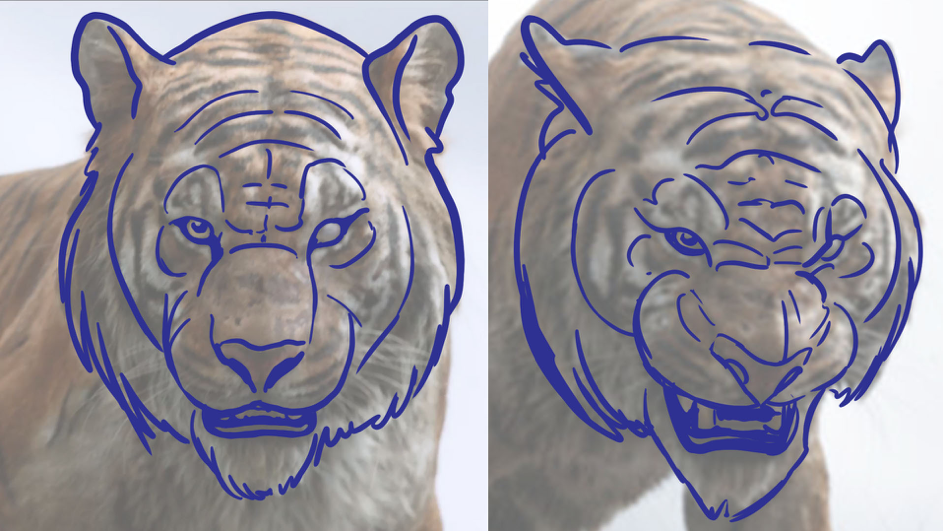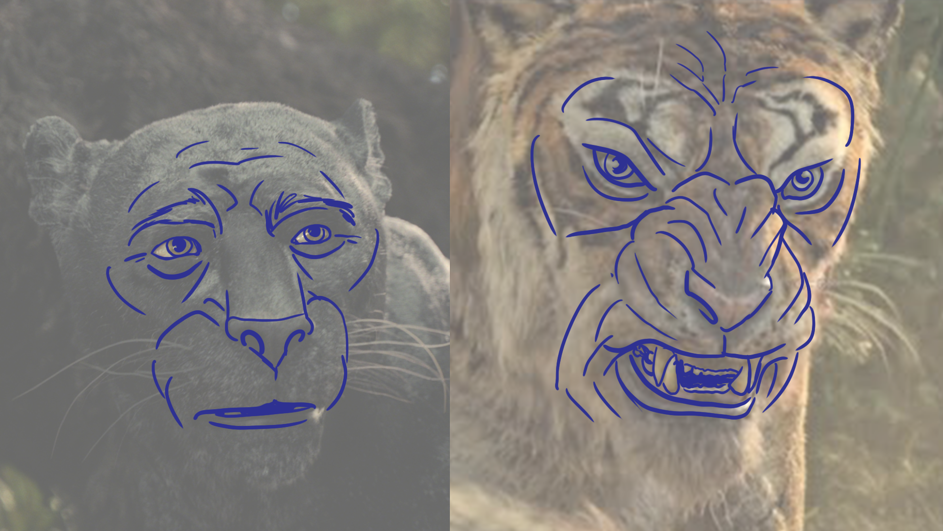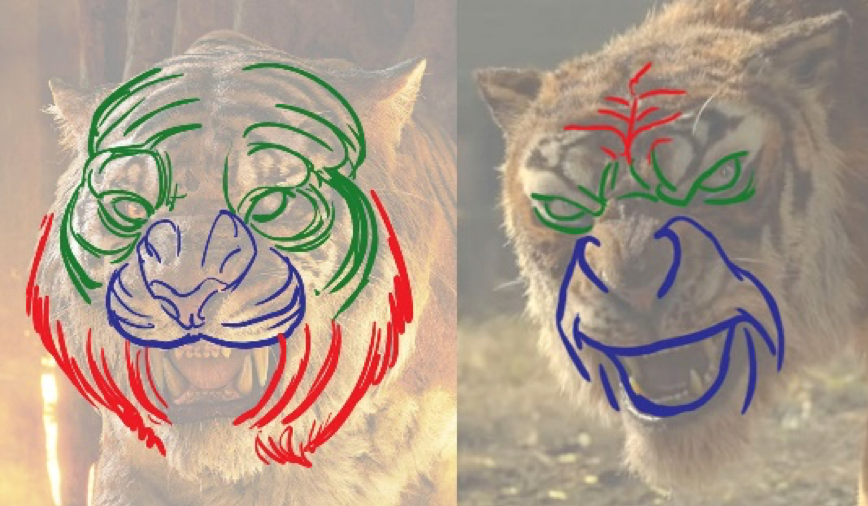The Warner Bros. production Mowgli: Legend of the Jungle (2018, by Andy Serkis) uses motion capture for animating the animals. After seeing this film, we were left with a strong, yet uncanny fascination. In order to look further into this, we will compare Mowgli with the Disney classic The Jungle Book (1967, by Wolfgang Reitherman) and the recent remake The Jungle Book (2016, by Jon Favreau).
Animated animal characters always tell stories about animals as well as humans. They raise questions “about the status and implication of the use of animation, and the symbolic assumptions about animals in relation to humankind” (Wells 2009: pos. 78). The three films we have chosen to look at achieve this in different ways.
The tendency to infuse the designs of the animals with human characteristics is clearly visible in the characters of the hand-drawn, 2D animation film The Jungle Book from 1967. The animals’ forward-facing eyes resemble human eyes, while in older films like Snow White and the Seven Dwarfs (1937, by David Hand) the eyes of the animals sit on both sides of the face, thus looking more animal-like. Certain human stereotypes inform the designs, like the squared chin of Shere Khan, a sign for his aristocratic and distinguished nature.[1] However, when Shere Khan is about to attack his prey, his facial features change into that of an animal, his widened gaze becoming calm and concentrated. When the tiger is disturbed shortly after, he looks up, lowers his eyebrows in anger and shakes his head in an over-acted anthropomorphic gesture. This constant shifting in the animation between animal and human features establishes Shere Khan as the antagonist in the story, while his wild and innocent animal nature marks him as part of the mystified and romanticized lost world of the jungle. Similarly, the animated vultures are shown moving from one leg to the other, as it can be observed when vultures on the ground trying to avoid stepping on their long wings. However, the timing of the animation changes, looking at times like a dance, then blending very naturally into animal behavior. Following Paul Wells’ argument, Disney’s 1967 Jungle Book creates animated “animals-in-the-making” that represent and challenge the conditions of the “naturalcultural”.[2] Animation as a practice here functions as “unthinking or undoing of the conventionally human” (Baker in Wells 2009: pos. 339).
The Jungle Book from 2016 combines live-action footage with computer-generated photorealist animation. The animated animals’ bodies are much more in motion than in the 1967 classic, poses are rarely held (a device used in cartoons to create anticipation and to show a character’s intentions). The perceptual realism[3] stresses their animality. Still, the animation uses classical principles like squash and stretch and clear shapes to create emotional expressions.

Overpaint: Lukas von Berg.
Mowgli approaches the animation through performance capture.[4] Facial and body movements for the (quadruped) animals were captured with human actors.[5] In this process, the animators’ work of modifying and adjusting the captured data for the final animations were minimized. This shows a clear intention to anthropomorphize the animals.[6] Like the 2016 The Jungle Book, Mowgli reaches a large degree of perceptual realism through a high level of detail in fur, skin, and texture. However, to transfer the captured movement data, the anatomy of the animals had to be humanized, with big heads, a large distance between eyes and nose, and short fangs.

There are a lot of minuscule movements in the facial muscles, but the overall facial shape and form stay the same. In The Jungle Book from 2016, the small movements are lacking, mouth shapes are more subtle, but are connected to cheeks and flews so that there is a dynamic in the facial shape.

When Bagheera hunts Mowgli and the wolves, he clearly switches into the mode of the wild animal. Yet, especially the facial animation tries to reduce the bestial features in order to transfer the captured human movements. This does not lead to more diversity in the animation, but rather limits animation’s potential to resist the “modes of realism” (Wells 2009: pos. 505): to express intentions, feelings and reactions through poses, timing, squash and stretch, secondary action, clear shapes and other modes of animation.
For our conclusion, we use the representational categories developed by Paul Wells in his “besital ambivalence model.” In this model, Wells (2009: pos. 879ff) identifies four polar extremes in the representation of animated animals. In “pure animals”, known animal traits and behaviours are shown in design and movement. The “aspirational human” function uses the animal’s character in order to show “favourable human qualities” (Wells 2916: pos. 892). The “critical human” context is used to critique human behaviour. “Humanimality” represents animals as symbols or metaphors (Wells 2916: pos. 879ff).
The world in the 1967 hand-drawn animation film is clearly marked as a cartoon world, fantastic and fictional, the animation following the classic Disney principles as they have been outlined by Thomas and Johnson (1982). The animals show some traits of “pure animals” (Wells 2009: pos. 879f), but by applying classic animation principles in a cartoony style, the animals clearly represent “aspirational human” and “critical human” modes while also functioning as metaphors for human behavior. The same is true for the version of 2016. Despite the photorealist look and the more naturalist movements of the animals, the animation in the 2016 The Jungle Book still uses classic Disney animation principles while aiming at perceptual realism, thus apparently strengthening the representation of “pure animal”. In Mowgli, the “pure animal” is present in movement, design and look, while human facial features and movements are directly transferred onto the animals. Mowgli thus reduces the beast in the animals in favor of human traits. This results in uncanny creatures that seem rather like human ghosts than animals. The human becomes animal, which is dramatically played out when Mowgli is kept in the cage like a wild beast. The film thus introduces a posthuman perspective: it questions a human-centered point of view when it represents animals not with respect to humans – as symbols, danger, metaphors, companions – but as humans. The destruction of the jungle and its inhabitants by humans is told by the snake Kaa at the beginning of the film and it becomes obvious when Mowgli discovers that his friend Bhoot has been killed and stuffed by the British hunter. Mowgli discusses this by turning the humans into animals representing their “animalhumanity,” thus questioning the supremacy of the human perspective.
Tina Ohnmacht has an MA in Literature and Film and media studies. She has held several positions since 2002 at Filmakademie Baden-Württemberg and works now as project supervisor and lecturer in History of Animation. Apart from that, she is a Ph.D. student at the University of Tübingen, where she writes on water in animation films.
Lukas von Berg has studied design with a focus on illustration in Muenster. There, he started using traditional cartoon animation for educational short films and is now also working in 3D animation. Since 2015, he has been studying animation at Filmakademie Baden-Württemberg, where he specializes in character animation for VFX.
References
Kissel, Theodor (2018). “Ein Weltreich in den Betten”, Spektrum.de: https://www.spektrum.de/news/ein-weltreich-in-den-betten/1614364 (last viewed 18 May 2019).
Prince, Stephen (1996). “True Lies. Perceptual Realism, Digital Images, and Film Theory”. In: Film Quarterly 49 (3), pp. 27–37.
Thomas, Frank; Johnston, Ollie (1995). The Illusion of Life. Disney Animation. Glendale: Disney Publishing.
Wells, Paul (2009). The Animated Bestiary. Animals, Cartoons, and Culture. New Brunswick: Rutgers University Press. Kindle Edition.
Williams, Richard (2001). The Animator’s Survival Kit. A Manual of Methods, Principles and Formulas for Classical, Computer, Games, Stop Motion and Internet Animators. New York: Faber and Faber.
[1] According to journalist Theodor Kissel, this anatomic feature is a result of an incest practice over many generations in the Habsburg dynasty between the 15th and the 17th century. https://www.spektrum.de/news/ein-weltreich-in-den-betten/1614364, 17.4.2019
[2] Wells (2009: pos. 313) refers to Donna Haraway’s notion of naturalcultural practices creating concepts-in-the-making, which are never stable but constantly renegotiated.
[3] “A perceptually realistic image is one which structurally corresponds to the viewer’s audiovisual experience of three-dimensional space” (Prince 1996: 32). Thus, animated images can be perceptually realistic.
[4] Andy Serkis coined the term “performance capture” instead of “motion capture” to stress the fact that it is acting that is recorded and not mere movement.
[5] Richard Williams discusses at length that quadruped movement cannot be compared to the tandem movement of two humans (Williams 2001: 327ff).
[6] According to a Facebook post by
concept artist and animator Aaron Blaise who worked on the character designs in
an early stage of the film, Andy Serkis deliberately moved away from naturalist
animal anatomy.
https://www.facebook.com/AaronBlaiseArt/media_set?set=a.10216892039107769&type=3,
18.02.2019

i am a Wild life illustrator loved your article.
Thank you, Debra